Goldfish range in size from just a couple inches long to over a foot long and considered one of the prettiest fish in the world.
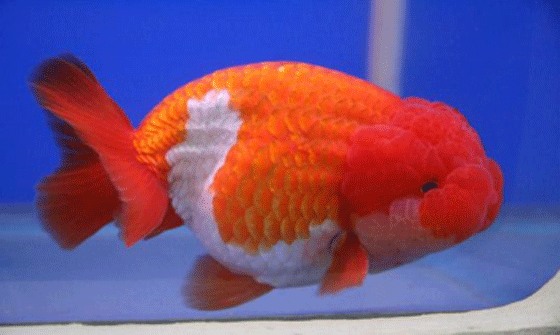
There are a wide variety of goldfish that can be classified in many ways. Ichthyologists (people who study fish) classify them according to:
- Their head and body shapes
- Their markings or their origins
- Others classify them according to their tail structure
Click the link below for the specific type of goldfish to learn more about them.
Single Tailed goldfish
Less common or hybrid
Many breeders have cross-bred their goldfish and created derivatives of the original. An example of a cross-bred goldfish is the Lionchu, which is a hybrid of the Ranchu and Lionhead goldfish.

Another example of a hybrid goldfish is the Common Globe-eyed goldfish, which is a cross between the Common and Telescope varieties.

There are over 100 varieties of goldfish. However, realistically, there’s basically between 20 and 25 original types of goldfish with the balance of them being *hybrids. (Hybrid means the offspring of 2 fish of different varieties)
So we can better understand the differences between the varieties of goldfish, it’s helpful to first understand the external anatomy of a goldfish. The different types of fins, tails, etc., are the key identifiers that set them apart.
Single tailed goldfish
Common goldfish

- size: up to 12 – 14 inches long
- body shape: slender
- coloring: orange/red, yellow
The Common goldfish has a single, short tail or caudal fin. It’s very distinct with a deep fork. When they’re first hatched, the baby fish are very dark and most will get lighter as they age.
The anal and caudal fins of the Common goldfish are not divided like many others.
This particular goldfish will grow into its environment and would best be suited in a pond or fish tank. The tank should be between 25 – 40 gallons in size.
The Common goldfish is a community fish and can pretty much live with others.
If you have a Common, you will not need any other scavengers in the environment. It will eat almost anything.
Its diet consists of:
- Pellets and flakes
- Spinach, cucumbers, lettuce, peas
- Frozen krill, bloodworm, daphnia
Comet goldfish
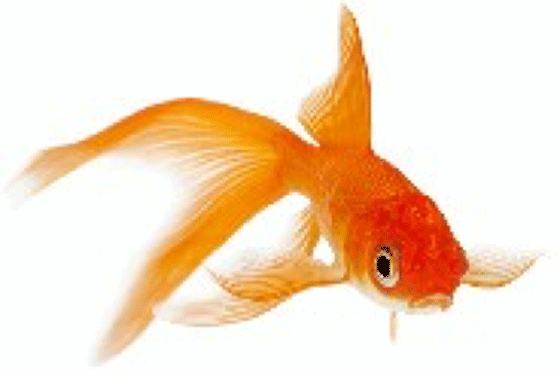
- size: up to 12 – 14 inches long
- body shape: slender
- coloring: red, orange, red/white
Comets are one of very few goldfish that have only one caudal fin, which is deeply forked. Most goldfish have 2 and are seen as flawed if they only have 1. The caudal fin should, ideally, be as long as, or longer than the body of the fish.
The Comet also has paired pectoral and pelvic fins which are long and end in a point.
The best environment for a Comet to live in is a pond or fish tank that holds at least 30 gallons of water.
The Comet eats anything that fits into its mouth. It’s not recommended that they live with other fish, especially those that are smaller. This is because they will eat anything and everything without regard for others.
Food for Comets can include:
- Pellets and flakes
- Spinach, cucumbers, lettuce, peas
- Frozen krill, bloodworm, daphnia
Shubunkin

- size: up to 10 inches long
- body shape: slender
- coloring: calico – black, white, red, orange, and brown on a silvery-blue / lavender background
Shubunkin are one of the few goldfish that have a single tail and with a similar build to the Common goldfish. There are 2 types of Shubunkins, the London and Bristol.
- The London Shubunkin has long fins similar to those found on Commons.
- The Bristol Shubunkin, on the other hand, has rounded, lobe-like fins, especially the caudal fins. This fish was bred from the Telescope and Demekin goldfish.
Because of its potential size, the Shubunkin likes to live in ponds or fish tanks that have a capacity of at least 30 gallons.
The Shubunkin is not a picky eater. Due to its speed and willingness to eat anything and everything, it is not a good idea to house the Shubunkin with slower fish.
The Shubunkin will eat:
- Pellets and flakes
- Spinach, cucumbers, lettuce, peas
- Frozen krill, bloodworm, daphnia
Double tailed goldfish
Wakin goldfish

- size: over 10 inches long
- body shape: slender
- coloring: red/white
The Wakin is starting to gain in popularity. It has a body built similarly to the Common except that it has fan-shaped caudal fins. Its fins come in pairs throughout its body.
Wakins have unique markings and are easily identifiable as no two are alike. Some are almost entirely red or white while most have patches of each color.
Because the Wakin is such a proficient swimmer, (it’s fast and agile), it can live with the Common or Comet goldfish pretty easily in ponds and large aquariums that hold at least 30 gallons of water.
It’s not a good idea to house Wakins with other, slower goldfish. The slower fish will die due to the lack of food. When it comes to the Wakin’s diet, it’s an *omnivore.
It will happily eat:
- Pellets and flakes
- Spinach, cucumbers, lettuce, peas
Fantail goldfish

- size: about 6 inches long
- body shape: egg-shaped
- coloring: red, orange, and anything in between
The Fantail is one of the oldest varieties around. The origin of the fantail goldfish dates back more than a thousand years.
It has a double caudal fin, giving it 4 lobes. The dorsal fin is high, prominent and most desirably about a third to a half of the body depth.
It’s Japanese relative is the Ryukin. Fantail is the western form of the Japanese fish and has a high dorsal fin, a shoulder without the hump, an egg-shaped body, and a quadruple caudal fin.
The finnage is less developed than that of the Ryukin. The dorsal fin on the fantail is enlarged and comprises approximately 33% of the fish’s body length.
This fish is available in many colors, ranging orange to red and the colors between.
The Fantail can live in both ponds and tanks, although it is sensitive to the temperature of the water. It’s best if the water is 65 – 78 degrees fahrenheit. If you keep them in ponds, make sure the pond is deep enough so that there’s a layer of warmth at the bottom where it can lie dormant during the colder months.
Considered an *omnivorous fish, they can be fed:
Jikin goldfish

- size: up to 9 inches long
- body shape: slender
- coloring: white body with red or orange points (fins)
The anatomy of a Jikin is much like a Common, however, it has a very unique double-caudal fin. From behind, it looks like the letter “x” with 4 distinct parts, and fans out beautifully. It’s developed from a Wakin and is similar in features but not body shape.
The Jikin is rarely found, even in specialized aquarium stores.
Jikin display calico coloration, which in other words can be described as exhibiting red and white colors on their body. Just like all other variants of fancy goldfish they can possess different qualities. The most valued specimen of Jikin has an all-white body bright red fins, lips and gill plates. High quality Jikin will not display any other color other than white on their body and red to orange coloration on the mentioned fins, lips and gill plates. The brighter red the color of the fin, lips and gill plates, the higher quality of fish.
Jikins are rather hardy and can live in both ponds and tanks, although it thrives outside under the sunlight, which brings out its reds and oranges. It also responds well to algae. In my opinion, the Jikin is best if you are looking for a beautiful pond fish.
The Jikin is *omnivorous and prefers to eat:
- Pellets and flakes
- Spinach, cucumbers, lettuce, peas
Pearlscape goldfish

- size: up to 8 inches long
- body shape: egg-shaped, some with head growth
- coloring: calico – brown, violet, yellow, orange, red
The Pearlscale is egg-shaped like many of its relatives although its mid-section is significantly larger and bulkier, making it almost round.
The Pearlscale got its name from the pearl-like bumps on its body. Their scales are actually humped or dome shaped which gives them their unique appearance. They have double anal and caudal fins.
There is also a variety of Pearlscales that have bumps on their heads known as Crown Pearlscales. The Japanese call this fish the “chinshurin.”
Pearlscales like to live in both ponds and tanks. They are, however, sensitive to large fluctuations in water temperature so if they’re in the pond, it needs to be in a temperate climate. If in a tank, the smallest capacity should be a 10 gallon tank. This is not ideal and the bigger the space, the better. (ie. 20-30 gallon for 1 fish and increased size by 10 gallons for additional fish.)
Pearlscales are not picky eaters. Much like their relatives, they will eat anything but they do require a little more attention when it comes to feeding time.
Since their internal organs are extremely cramped in their round bodies, their pellets and flakes need to be soaked in water before being fed to them. This allows the pellets and flakes to absorb water and expand before entering the fish’s body. The food is better expanding outside the fish rather than inside.
Its diet can include:
- Pellets and flakes
- Spinach, cucumbers, lettuce, peas
- Frozen krill, bloodworm, daphnia
Oranda goldfish

- size: up to 12 inches long
- body shape: egg-shaped with wen (head growth)
- coloring: red, red/black, red/white, blue, bronze, black, calico
The Oranda is one of few that have a head growth, or wen, on the top of its head. The wen is bumpy, resembling the texture of a raspberry. The more developed the wen, the more prized the goldfish.
The wen takes up to 2 years to develop.
The Oranda has a high dorsal fin that begins right behind the wen. It’s a cross between Veiltails and Lionheads. Since Orandas’ wens are prone to bacterial infections, it’s recommended that these fish are cared for by experienced fish keepers.
Due to its size, it’s best to keep the Oranda outside in a pond. It adapts well to a variety of temperatures, allowing it to be a hardy outdoor fish. If in a tank, be sure the Oranda has at least 20 gallons of water to swim around in regularly.
It’s not a good idea to put the slow-moving Oranda in a pond with the faster goldfish as it will likely die of starvation.
The Oranda is not a picky eater. It will need, however, the pellets and flakes soaked before eating them so they don’t expand in their bodies.
They like to have a variety of foods, including:
- Pellets and flakes
- Spinach, cucumbers, lettuce, peas
- Frozen krill, bloodworm, daphnia
- Cocktail shrimp (from the grocery store)
Ryukin goldfish

- size: up to 6 inches long
- body shape: egg-shaped with a hump behind its head
- coloring: red, white, red/white, blue, chocolate, calico
The Ryukin is named for the Ryukyu Islands that lie between Taiwan and Japan. This fish arrived in Japan sometime between 1770 and the early 1800s and has become one of the most popular goldfish in Japan.
Ryukins are one of the most beautiful; however, they’re also one of the most aggressive. These are the “bad boys” of the goldfish kingdom.
The Ryukin is built very similarly to the Fantail, except for its very distinct hump. Its tail can come in many forms, including long-finned, short-tailed, ribboned, or like a butterfly.
Ryukins live best in tanks that are over 20 gallons. Due to its deep body, it’s prone to creating a great amount of waste and ammonia, requiring the tank to be cleaned regularly.
When it comes to feeding a Ryukin, it’s best to avoid all pellets and flakes. This goldfish is prone to swim bladder issues and needs to be carefully selected.
It prefers to eat:
- frozen krill, bloodworm, daphnia
- algae and live plants
- zucchini, lettuce, peas
Moor goldfish

- size: up to 10 inches long
- body shape: egg-shaped with telescope eyes
- coloring: black
Moors are black in color and look almost velvety as their scales have a golden tinge to them. They have single, high dorsal fins. The caudal fins are rounded or lobed.
Their eyes protrude from their heads, but rather than seeing up like the Celestials, they see off to the side like the Telescopes.
Moor goldfish don’t live well in ponds and prefer to be in aquariums with other fish with bad eyesight. It’s not a good idea to place Moors with faster, bigger fish.
This type of goldfish is also very social and swims near and around other fish without any form of hostility. Black Moor goldfish have been known to dig up gravel and plants. They need plenty of room to swim as it’s a relatively wide fish. Sharp edges on tank decorations are discouraged due to their somewhat fragile eyes.
Like most other goldfish, Moors are not picky when it comes to their diets. They do, however, take a little longer to feed as they have very poor eyesight and take a while to identify their food.
They will eat:
- pellets and flakes
- spinach, cucumbers, lettuce, peas
- frozen krill, bloodworm, daphnia
Telescope goldfish

- size: up to 8 inches long
- body shape: egg-shaped with telescope eyes
- coloring: red/white, white, orange, calico
The Telescope is basically the orange version of the Moor. Their eyes protrude and look off to the side. They have tall dorsal fins and lobed caudal fins.
The Red Telescope is also known as the Dragon Eye goldfish and Celestial Eye goldfish.
The most stunning feature of the Red Telescope is the large protruding eyes said to resemble those of a dragon. The Telescope variety of fancy goldfish has long been considered the most representative goldfish of China.
Telescope goldfish do best in aquariums with other poor-sighted fish. It does not do well with bigger, faster fish. Because the fish has sensitive eyes, it’s best to avoid putting plastic plants in the tanks with them. They may get scratched.
When it comes to their diet, Telescopes will eat:
- pellets and flakes
- spinach, cucumbers, lettuce, peas
- frozen krill, bloodworm, daphnia
The Red Telescope goldfish may have traditional metallic red/orange coloration but thanks to its distinct telescope eyes, it makes an eye-catching addition for the goldfish enthusiast.
Panda Moor goldfish
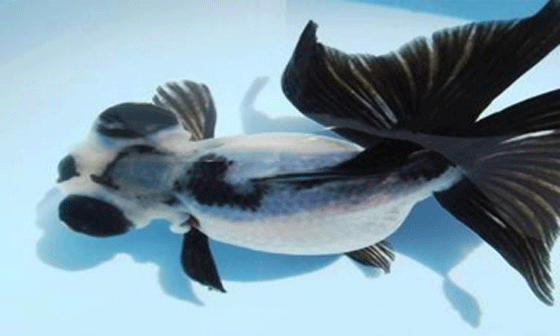
- size: up to 10 inches long
- body shape: egg-shaped with telescope eyes
- coloring: white with black points (fins) and oval patches
The Panda Moor is shaped just like the Moors and Telescopes. The only difference is their coloring which mimics that of Pandas.
Panda moors have delicate projecting eyes, deep bodies, and long flowing fins. Like any other moor, pandas can grow very fat. They are metallic-scaled.
Young moors resemble bronze fantails and their protruding eyes gradually develop with age. They sport a velvety appearance in maturity. However, they may lose this velvet-like appearance with increasing age.
Panda Moors, just like their relatives, are best kept in fish tanks with other fish with poor eyesight. This is a relatively new breed of goldfish, but can be found easily. It’s very social and will play well with other goldfish.
This is a hardy fish, but it doesn’t like cold water temperatures.
Panda Moors are fun, friendly fish and a welcome addition to any tank as they add something very different to the look of your fish water world.
Panda Moors will eat just about anything, including:
- pellets and flakes
- spinach, cucumbers, lettuce, peas
- frozen krill, bloodworm, daphnia
Pompom goldfish

- size: up to 5 inches long
- body shape: egg-shaped with over-developed nasal septa
- coloring: black, red, orange, white, blue
Pompom goldfish are named as such because of the fleshy pompoms sticking out of their noses. These Pompoms are over-developed septa and some are more prominent than others.
Some Pompoms lack a dorsal fin.
The Pompom can trace its origin back to China. However some fish experts also state that the Pompom goldfish also originated in Japan.
The appearance of the Pompom is slightly similar to that of the Lionhead goldfish, at least in the shape of its body, as well as the placement of the fins. However the most distinguishing feature of the Pompom is the 2 fleshy knobs that extend out the front of its head. These growths are fairly spherical in shape, and are said to look like the pompoms of a cheerleader. The size of these pompoms can vary and may not be proportionately even in all fish.
Since Pompoms are relatively small, they are very happy in aquariums, preferably heated. They don’t have a hard time competing with other fish despite the size of their noses. They are prolific swimmers and prefer larger spaces.
Pompom goldfish enjoy live plants the most when it comes to their diets.
They will also eat:
- pellets and flakes
- spinach, cucumbers, lettuce, peas
- frozen krill, bloodworm, daphnia
Veiltail goldfish

- size: up to 8 inches long
- body shape: egg-shaped with long veil-like fins
- coloring: orange/white
Of all the varieties of goldfish, the Veiltail has the highest dorsal fin. Its caudal fin flows delicately like a bride’s veil, thus its name. Their anal fins are also very long and veil-like.
Preferably they have a square- edged tail rather than a round, lobed one. The body should be short and rounded with a smooth outline.
The Veiltail goldfish standard requires the trailing edge of the caudal fin to be free from forking or pointed lobes. A perfect Veiltail must have a single dorsal fin and all other fins paired. A Veiltail of high quality sports a strong color intensity that extends all the way to the fins.
Due to its sensitive and delicate fins, Veiltails are best kept in aquariums with no plastic plants in them. They also prefer warmer waters no colder than 60 degrees fahrenheit.
Veiltails will eat most foods, however, much like their egg-shaped counterparts, their organs are very sensitive. This requires them to eat presoaked pellets and flakes.
Their omnivorous* diets include:
- pellets and flakes
- spinach, cucumbers, lettuce, peas
- frozen krill, bloodworm, daphnia
The Veiltail is a very gracious and beautiful fish and it comes as no surprise that it’s very popular among goldfish keepers and breeders.
Eggfish

- size: up to 6 inches long
- body shape: egg-shaped, dorsal-less
- coloring: orange, white, orange/white
The “Egg-fish” or “dan yu”, dates back about 800 years in the history of goldfish breeding in China. It’s believed to be the ancestral link of today’s Celestials, Ranchus and Lionheads.
The Eggfish is similar to many other types of goldfish in that they are Lionheads without wens (head bumps), Celestials with normal eyes, or Pompoms without enlarged nasal septa. They have long, veil-like caudal fins which are mildly forked. The rest of their fins are disproportionately smaller.
The Egg-fish is not a very well-known fish. Breeders have had a hard time maintaining an adequate blood line, and with the ever-changing tastes of goldfish fanciers, they have become extremely rare in China.
Eggfish prefer to live in 30 gallon aquariums although there is no reason they couldn’t live in a pond. They’re not particularly great swimmers due to their size, but can still survive with Commons and Comets.
Eggfish will eat pretty much anything but prefer:
- pellets and flakes
- frozen krill, bloodworm, daphnia
Lionhead goldfish

- size: up to 10 inches long
- body shape: egg-shaped with wen (head growth)
- coloring: orange, black, red, red/white, red/black, calico
The Lionhead is by far the most popular and well known of the dorsal-less goldfish. Rather than having the long slender body of the Common goldfish or the Shubunkins, the Lionhead is one of the more rounded or egg-shaped fancy goldfish.
This fish was bred in China to develop a “hood” that depicts the image of the mythical Chinese lion-dog. The distinctive raspberry or lion’s mane appearance of the Chinese Lionhead goldfish have led to its common name ‘Lionhead’ .
The amount of head growth differs for each fish. For some the broad head, except for its eyes, mouth and nostrils, can become completely covered with fleshy growth (sometimes impeding their vision) while others will develop hardly any head growth at all.
The dorsal-less Lionhead is a close relative of the Eggfish. They do, however, have the raspberry-like growths, or wens, on their heads. Sometimes the wen becomes bothersome for the fish, especially when it gets so big it interferes with its gills.
The Lionhead can thrive in both fish tanks and ponds. They prefer larger fish tanks and can survive well with other fish their size. If in a pond, try not to house Lionheads with Comets or Shubunkins. These goldfish are more aggressive.
Lionhead prefer to eat:
- pellets and flakes
- frozen krill, bloodworm, daphnia
Ranchu goldfish

- size: up to 14 inches long
- body shape: egg-shaped with wen (head growth)
- coloring: orange, black, white, red, orange/white
The Ranchu is known as the “King” of goldfish. They are very similar to a Lionhead, except that their backs are arched and they have shorter tails. They too lack a dorsal fin. The ideal Ranchu closes up its tail as it swims and opens it up like a fan, splaying sideways, when it comes to a standstill.
The Ranchu was created in China during the Meiji period but it was the Japanese who created the Ranchu’s we know today. They are known to be a very friendly fish and some fish keepers are able to pet their Ranchu and even to train them to do some tricks.
The Ranchu are more suited to ponds than fish tanks but if you provide enough space, (30 gallons or more), he can be kept in an aquarium.
They are best kept with other goldfish or large coldwater species due to the fact that it’s a coldwater fish. Don’t mix it with tropical fish as it requires a lower temperature than tropical fish. Ranchu are notoriously filthy, producing much waste, frequent water changes and a good filtration system is essential.
It’s important to feed Ranchus a variety of fresh and frozen or dried foods.
They enjoy eating such things as:
- pellets and flakes
- frozen krill, bloodworm, daphnia
- lettuce, zucchini, cucumber
Celestial goldfish

- size: up to 8 inches long
- body shape: egg-shaped with telescope eyes
- coloring: red, orange, yellow, brown, black, calico
The Celestial has telescoping eyes like the Moors and Telescopes, however, rather than looking out, they look up. This dorsal-less fish is born with normal-looking eyes but as it grows up, they start to stick out and turn up. They have curved backs.
When you first see this goldfish you might think it looks sad, but it’s just living up to its nickname ‘Stargazer’, and its eyes really do gaze up at the heavens.
Because this goldfish is looking upwards, its vision is limited. It should be kept with other types of goldfish that also have limited eyesight. That way each fish has a fair chance of finding food.
The eyes are very delicate so there shouldn’t be anything in the aquarium that could damage them. Sand should be on the bottom of the fish tank, and aquatic plants rather than silk ones, as they can sometimes be scratchy. You shouldn’t have a filter in the aquarium for this type of fish as this too could hurt their eyes.
Celestials, like Moors and Telescopes, prefer to live in aquariums of 20 gallons or more. They don’t survive well with faster, stronger fish. In order to do well, they should be housed in tanks with fish that have poor eyesight just like them.
Like many other goldfish, Celestials are not picky eaters.
Their diets include:
- pellets and flakes
- spinach, cucumbers, lettuce, peas
- frozen krill, bloodworm, daphnia
Bubble Eye goldfish
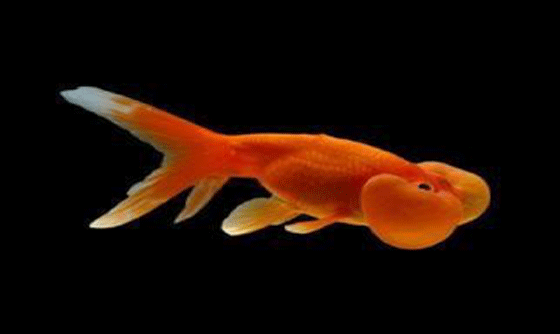
- size: up to 5 inches long
- body shape: egg-shaped with telescope eyes
- coloring: red, red/white, red/black, black, chocolate, calico
Some people absolutely love the Bubble Eye; others cannot stand its sight. This goldfish is built much like the Celestial, with eyes turning upward, except for the 2 liquid-filled sacks under each eye.
The Bubble Eye’s liquid sacks prevent it from doing well in ponds. Due to its small size, it’s fine to house in a fish tank. Avoid placing plastic plants in the tank with this delicate fish. It does best with other poor-sighted fish like itself.
Bubble eye goldfish are thought to have originated in China a long, long time ago as the result of a mutation being bred into other forms of large-eyed goldfish. One possible reason for such a mutation being encouraged is that in ancient China, goldfish were kept in jars (aquariums hadn’t been invented). Therefore the only way to view the goldfish was from above. This could also explain why, in common with other “fantail” goldfish, there is no dorsal fin, and a split tail fin.
As with all fancy goldfish, the bubble eye can be susceptible to swim bladder problems because of their more rounded body shape.
It’s difficult for the Bubble Eye to find food, therefore it’s wise to feed it food that sinks slowly, such as:
- flakes
- lettuce, spinach
- brine shrimp, bloodworms, tubifex worms
Tosakin goldfish

- size: up to 8 inches long
- body shape: egg-shaped
- coloring: orange/white, red, white, calico, yellow
The Tosakin goldfish thrives in the pond. It has a beautiful fan-tail that is best viewed from above. It’s the only goldfish with an undivided, double caudal fin which makes a complete circle when it is opened up.
Mottled orange and white seems to be the dominant color of most Tosakins, but they can also be found in red, white, calico, black, and yellow. As with other goldfish, color that saturates the fins is desirable, but transparent fins seem to be common in this breed.
Even though the Tosakin prefers to live in ponds, it’s important to make sure its pond-mates are not aggressive.Tosakins are very weak swimmers. The fragile tail need to be taken into consideration when placing Tosakins in ponds. They also do better in temperate climates without much fluctuation.
Originally bred from Ryukin ancestors by Japanese Samurai in the mid-1800s in the Kochi prefecture of Japan. The fish almost became extinct after an earthquake but was revived in the mid-20th century. Even so, it’s very rare within Japan and almost unheard of within the US. Naturally, this also makes it expensive.
Tosakin is the caviar of goldfish when it comes to pond fish. The price tag reflects this. Top quality Tosakins sell for much as Ranchus. Many hundreds of dollars.
The Tosakin’s diet includes:
- pellets and flakes
- spinach, cucumbers, lettuce, peas
- frozen krill, bloodworm, daphnia
Less common or hybrid goldfish
Butterfly Tail goldfish

- size: up to 9 inches long
- body shape: egg-shaped
- coloring: black, orange, white with orange points (fins)
This is the same fish as the Japanese Jikin. In the United States and other countries outside Japan, this particular fish is bred in other colors, unlike the Jikins which is white with orange points.
See Jikin goldfish description for more information.
Lionchu goldfish

- size: up to 6 inches long
- body Shape: egg-shaped with wen (head growth)
- coloring: orange, orange/white, yellow
The Lionchu is a cross-breed between a Ranchu and a Lionhead. It has a broad, curved back and does not have a dorsal fin. It became classified as its own type of fish rather than a “mongrel” in 2006.
Seibun goldfish

- size: up to 12 inches long
- body shape: egg-shaped
- coloring: black with blue markings
Very little is known about the Seibun goldfish except that it is related to the Oranda.
Sakuranishiki goldfish

The Sakuanishiki goldfish is simply a Ranchu that includes the pearl-like color on it somewhere. Some are fully pearl-colored while others, like the fish pictured, only have particular markings in pearl.
Shukin goldfish

The Shukin is a hybrid between the Ranchu and Oranda. It’s dorsal-less with a slightly curved back. It has a long body-shape like the Ranchu and long caudal fins like the Oranda. They are red, blue, silver, or white.
The Shukin is a rare goldfish, even in Japan, where it was developed in 1892. It has already been wiped out once, during World War II, and revived by the Japanese.
Izumo Nankin goldfish

The Izumo Nankin is simply a red and white version of the Ranchu. The purest of all Izumo Nankins would be predominantly white with no red markings on its head at all. Compared to most Ranchu the Izumo Nankin has little to no wen or head growth.
Some people mistake the Izumo Nankin as a type of Eggfish.
Demekin goldfish
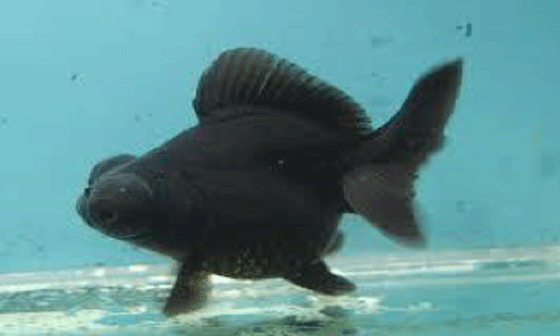
The Demekin is a cross between Ryukin and Telescope goldfish. They have the large telescoping eyes from the Telescope and a humped back from the Ryukin. Most Demekin are black or have some kind of black marking on them.
There’s many more goldfish varieties that are all hybrids or color variations like the ones listed here. Depending on where the goldfish are found, they are bred with certain colorations and features. Almost any combination is possible making the variety endless.
*0mnivore – An animal that eats a variety of food of both plant and animal origin
